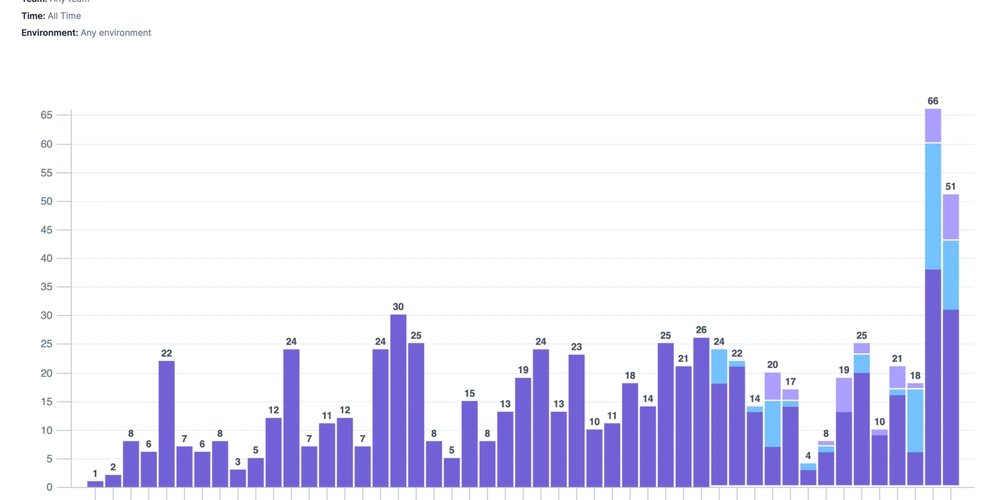Asynchronous Communication: Making the Most of Time Zone Differences with Offshore React Developers
Modern businesses operate globally, and remote work has transformed the way teams collaborate. This shift has enabled many tech companies to tap into a worldwide talent pool. Hiring offshore developers, especially across different time zones, can solve several challenges. These teams can keep projects moving around the clock and often at a lower cost. Of course, this setup needs a proper plan so that time and language differences don’t disrupt the workflow. If you're planning to hire dedicated React developers members from offshore locations, this blog will guide you through how asynchronous communication can boost productivity. We’ll also share tactics for managing developer time zones to keep collaboration smooth and efficient. The Rise of Offshore Development Teams Today, using high-speed internet and tools to collaborate in a better way; people all over the world can work together effortlessly without worrying about where they are located geographically. One of the most advantageous features associated with React JS is its capacity to hire React Js development team that is based from across the globe, being able to be competitive whilst reducing expenses in order for companies have a possibility to increase their development. But one of the biggest issues that companies deals with is a time zone problem. Offshore developers may work in time zones several hours ahead or behind regions where businesses operate, such as the U.S. and Europe. This can cause real-time communication gaps and delay decisions, which if not managed could be annoying. However, there is a way to make this challenge into an opportunity. Understanding Asynchronous Communication The key to doing this when you have an offshore development team in a different time zone is to shift your communication style towards asynchronous communication. It is a communication that does not require all concerned parties to communicate at the same time (like calls, video meetings, and messages). Instead, it allows each party to ask questions in their own multimodal or digital method. This kind of setup is beneficial, especially if you are working with offshore developers in different time zones that allow no downtime when the other team goes offline. Here are the main advantages of asynchronous communication Increased Productivity: By having such a system, developers can work in peace during their working hours. You don't have to wait for a manager or team member from another time zone to be online. Developers can take care of their tasks, solve bugs, and write code without having to wait for any honest, real-time feedback. Focus on Deep Work: Developers working on React likely need more significant chunks of time to write code and solve problems without being interrupted. Fewer interruptions from meetings or chat notifications = more productive coding and a faster project finish-up process. 24/7 Workflow: Well-managed, an offshore team in another time zone can get to work as you leave, so your development hours continue 24/7. The offshore team can work while your in-house team is offline helping you have an entire 24 hour development cycle. That means quicker resolutions to issues and faster project progress without needless delays. Tactics for Offshore Developer Time Zones In order to maximize the benefits of time zone differences with offshore React developers, a robust strategy using Asynchronous Communication must be in place. Here are a few practices that help you manage your team time zones for offshore developers: 1. Workflows and roles defined in the organization Workflows vary to a greater extent across organizations, which might not necessarily be due to its infrastructure. Clarify workflows and responsibilities. Each team (offshore or onshore) should deliver what is required from them. Use project management systems, e.g., Jira, Trello, or Asana, to keep order in tasks and their deadlines; Ensure the tasks you delegate are stand-alone and do not require extended give-and-take communication. In the meantime, it helps developers progress on their own without having to worry if they make the correct choice since answers will come eventually. 2. Use the Appropriate Tools for Documentation Effective asynchronous communication depends on thorough and accessible documentation. Tools like Confluence, Google Docs, and Notion are excellent platforms to store all project-related documentation, specifications, and guidelines. Make sure each task is adequately documented, and all team members will know where to look for the necessary information. This makes development a lot less blocked due to missing information. When hiring an offshore React development team, you must ensure they are brought on board correctly and with all the proper documentation available. This way they can be as productive during their working hours and not have to wait for an answer. 3. Leverage Time Zone Overlaps While it is e

Modern businesses operate globally, and remote work has transformed the way teams collaborate. This shift has enabled many tech companies to tap into a worldwide talent pool. Hiring offshore developers, especially across different time zones, can solve several challenges.
These teams can keep projects moving around the clock and often at a lower cost. Of course, this setup needs a proper plan so that time and language differences don’t disrupt the workflow.
If you're planning to hire dedicated React developers members from offshore locations, this blog will guide you through how asynchronous communication can boost productivity. We’ll also share tactics for managing developer time zones to keep collaboration smooth and efficient.
The Rise of Offshore Development Teams
Today, using high-speed internet and tools to collaborate in a better way; people all over the world can work together effortlessly without worrying about where they are located geographically. One of the most advantageous features associated with React JS is its capacity to hire React Js development team that is based from across the globe, being able to be competitive whilst reducing expenses in order for companies have a possibility to increase their development. But one of the biggest issues that companies deals with is a time zone problem.
Offshore developers may work in time zones several hours ahead or behind regions where businesses operate, such as the U.S. and Europe. This can cause real-time communication gaps and delay decisions, which if not managed could be annoying.
However, there is a way to make this challenge into an opportunity.
Understanding Asynchronous Communication
The key to doing this when you have an offshore development team in a different time zone is to shift your communication style towards asynchronous communication. It is a communication that does not require all concerned parties to communicate at the same time (like calls, video meetings, and messages). Instead, it allows each party to ask questions in their own multimodal or digital method.
This kind of setup is beneficial, especially if you are working with offshore developers in different time zones that allow no downtime when the other team goes offline.
Here are the main advantages of asynchronous communication
Increased Productivity:
By having such a system, developers can work in peace during their working hours. You don't have to wait for a manager or team member from another time zone to be online. Developers can take care of their tasks, solve bugs, and write code without having to wait for any honest, real-time feedback.Focus on Deep Work:
Developers working on React likely need more significant chunks of time to write code and solve problems without being interrupted. Fewer interruptions from meetings or chat notifications = more productive coding and a faster project finish-up process.24/7 Workflow:
Well-managed, an offshore team in another time zone can get to work as you leave, so your development hours continue 24/7. The offshore team can work while your in-house team is offline helping you have an entire 24 hour development cycle. That means quicker resolutions to issues and faster project progress without needless delays.
Tactics for Offshore Developer Time Zones
In order to maximize the benefits of time zone differences with offshore React developers, a robust strategy using Asynchronous Communication must be in place. Here are a few practices that help you manage your team time zones for offshore developers:
1. Workflows and roles defined in the organization
Workflows vary to a greater extent across organizations, which might not necessarily be due to its infrastructure.
Clarify workflows and responsibilities. Each team (offshore or onshore) should deliver what is required from them. Use project management systems, e.g., Jira, Trello, or Asana, to keep order in tasks and their deadlines;
Ensure the tasks you delegate are stand-alone and do not require extended give-and-take communication. In the meantime, it helps developers progress on their own without having to worry if they make the correct choice since answers will come eventually.
2. Use the Appropriate Tools for Documentation
Effective asynchronous communication depends on thorough and accessible documentation. Tools like Confluence, Google Docs, and Notion are excellent platforms to store all project-related documentation, specifications, and guidelines. Make sure each task is adequately documented, and all team members will know where to look for the necessary information. This makes development a lot less blocked due to missing information.
When hiring an offshore React development team, you must ensure they are brought on board correctly and with all the proper documentation available. This way they can be as productive during their working hours and not have to wait for an answer.
3. Leverage Time Zone Overlaps
While it is essential to respect the working hours of your offshore team, trying to find some small overlap can work miracles. Use this time for sync communication, e.g., fast stand-ups or, urgent discussions, and any related collaboration work.
For example, if your onshore team is in New York and your offshore team is in India — you have a few hours of overlap with the morning. Treat this time and utilize it to provide briefings, feedback, or immediate clarifications.
4. Implement the “Follow the Sun” Model
If you have a substantial impact of time zone differences on your work, then definitely use the "Follow The Sun" model. Organize your workday so that the team working a shift does another in another time zone. The work is done off of them when the offshore team signs off and onshore can continue where they left off or vice versa. This model works perfectly for high-tempo projects that are in need of underdevelopment, debugging, or a mixture of them.
5. Automated Workflows & Notifications
Since you will be working in different time zones, automation is your friend. Implement automatic notifications as tasks are completed, code is pushed, and issues requiring immediate feedback arise. Tools like Alerts GitHub, Slack, or Microsoft Teams allow you to automatically notify your colleagues every time an action is performed (so everyone can keep updated even without real-time messages).
You can even automate CI/CD (continuous integration and delivery) pipelines to test new code automatically on check-in. This way, developers do not have to run tests or deploy any new changes manually. That way, people are continuously working on it across all time zones.
6. Promote Feedback in an Asynchronous Format
So again, remember that asynchronous communication can mean slower feedback if used sub-optimally. To help resolve this, set rules on how feedback is done asynchronously. Make sure your feedback is more than just cursory and that it lists actionable steps.
For example, through video recording tools like Loom in order for members to leave a feedback related to particular pull requests or designs. This method saves time and keeps feedback understandable globally without the impact of different time zones.
7. Build a Trustworthy and Accountable Culture
With an out-of-the-box react development team across the shores means working asynchronously with trust and accountability. Build a culture that makes team members want to own their work, even when they are working alone. Set clear expectations, KPIs, or performance metrics so that everyone knows where the goalposts are and how trackable they should be, obviously with potential frequency.
If team members feel they are trusted to execute and the buck stops with them — then teams collaborate better, take more initiative, and can work autonomously even where there is minimal real-time oversight.
Conclusion
Offshore development, especially in React, has opened access to global talent like never before. But to make the most of this opportunity, businesses need to treat asynchronous communication as a priority to handle time zone differences effectively. It’s not just about hiring remote talent; it’s about building a system that supports them.
By focusing on clear workflows, solid documentation, planned overlapping hours, and smart automation, you can implement strong tactics for offshore developer time zones that help your React developers stay in sync with your core team. If you're investing in ReactJS development services, turning time zone challenges into structured workflows can make a huge difference in productivity and team unity.

_Andreas_Prott_Alamy.jpg?width=1280&auto=webp&quality=80&disable=upscale#)









































































![Apple Ships 55 Million iPhones, Claims Second Place in Q1 2025 Smartphone Market [Report]](https://www.iclarified.com/images/news/97185/97185/97185-640.jpg)

















![Google Home app fixes bug that repeatedly asked to ‘Set up Nest Cam features’ for Nest Hub Max [U]](https://i0.wp.com/9to5google.com/wp-content/uploads/sites/4/2022/08/youtube-premium-music-nest-hub-max.jpg?resize=1200%2C628&quality=82&strip=all&ssl=1)
![Severance-inspired keyboard could cost up to $699 – have your say [Video]](https://i0.wp.com/9to5mac.com/wp-content/uploads/sites/6/2025/05/Severance-inspired-keyboard-could-cost-up-to-699-%E2%80%93-have-your-say-Video.jpg?resize=1200%2C628&quality=82&strip=all&ssl=1)



























































































































































































































![[The AI Show Episode 145]: OpenAI Releases o3 and o4-mini, AI Is Causing “Quiet Layoffs,” Executive Order on Youth AI Education & GPT-4o’s Controversial Update](https://www.marketingaiinstitute.com/hubfs/ep%20145%20cover.png)
































































































































































![[DEALS] Mail Backup X Individual Edition: Lifetime Subscription (72% off) & Other Deals Up To 98% Off – Offers End Soon!](https://www.javacodegeeks.com/wp-content/uploads/2012/12/jcg-logo.jpg)
































































































